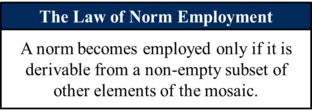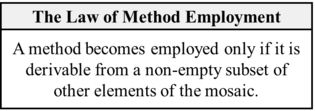Methodology and Methods
Can a method become employed by being the deductive consequence of an already accepted methodology? How would this affect the Methodology Can Shape Methods theorem?
A methodology is a set of explicitly formulated rules of theory assessment, and is a kind of theory, whereas a method is a set of requirements actually employed in theory assessment. Methods are implicit, and need not always correspond to the accepted methodology. The Third Law, the Law of Method Employment, would seem to imply that methods can be deduced from methodologies. However, the Methodology Can Shape Method theorem states that this can only happen if the requirements of the method implement abstract requirements of some other employed method, a seeming problem for the Third Law.
In the scientonomic context, this question was first formulated by Mirka Loiselle in 2016. The question is currently accepted as a legitimate topic for discussion by Scientonomy community.
In Scientonomy, the accepted answers to the question can be summarized as follows:
- A norm becomes employed only if it is derivable from a non-empty subset of other elements of the mosaic.
- A method becomes employed only if it is derivable from a non-empty subset of other elements of the mosaic.
Contents
Scientonomic History
Acceptance Record
| Community | Accepted From | Acceptance Indicators | Still Accepted | Accepted Until | Rejection Indicators |
|---|---|---|---|---|---|
| Scientonomy | 1 April 2016 | It was acknowledged as an open question by the Scientonomy Seminar 2016. | Yes |
All Theories
If an answer to this question is missing, please click here to add it.
Accepted Theories
Suggested Modifications
Current View
In Scientonomy, the accepted answers to the question are The Law of Norm Employment (Rawleigh-2022) and The Law of Method Employment (Rawleigh-2022).
Mechanism of Norm Employment
The Law of Norm Employment (Rawleigh-2022) states: "A norm becomes employed only if it is derivable from a non-empty subset of other elements of the mosaic."
Sebastien's law of method employment faces several problems. Foremost among these is that it is based on an outdated ontology that assumes that methods of theory evaluation are a fundamental epistemic element. After the acceptance of Barseghyan’s proposal that methods be subsumed under the category of normative theories, the third law no longer exhaustively covers all situations cases of employment. In its present form it is limited to methods, though there is no reason to think that the mechanism by which a method is employed is any different than the mechanism by which any other norm is employed.
In addition, Sebastien's formulation of the third law uses the term deducible, which currently lacks a scientonomic definition. We do not currently know what it means for something to be deducible, what the criteria of deducibility would be, or whether the conditions of deducibility would be part of the first-order theories of the mosaic or part of the second-order theories that range over the mosaic.
The third issue with Sebastien's formulation is that, with the acceptance of questions into the epistemic elements of the ontology of scientific change, the elements of the mosaic are now more expansive than just theories and subtypes of theories. This means that there is a plausible situation in which norms could potentially be derived – at least in part – from questions, which means that a formulation of the third law that excludes questions would fail to comprehensively describe all cases of norm employment.
The new law of norm employment aims to remedy all three of these issues:
- the formulation of the covers all norms rather than only methods;
- it replaces a deducible with derivable, which in the context of mathematical model theory simply means to be semantically entailed, and thus can potentially include non-deductive inferences (e.g. inductive, abductive);
- it replaces a specific enumeration of epistemic elements with a general "elements of the mosaic".
This formulation also offers the slight clarification that derivability strictly deals with derivation from a finite number of other elements.
Mechanism of Method Employment
The Law of Method Employment (Rawleigh-2022) states: "A method becomes employed only if it is derivable from a non-empty subset of other elements of the mosaic."
This law of method employment is a corollary of Rawleigh's law of norm employment. It implies that, just like the norms of all other types, methods become employed when they are derivable from other elements of the agent's mosaic (such as other theories, other methods, and perhaps even questions). As such, the law preserves most of the content of Sebastien's third law by solving some of the issues inherent in it.
See The Law of Norm Employment (Rawleigh-2022) for a more thorough exposition.
Related Topics
This question is a subquestion of Mechanism of Method Employment.
It has the following sub-topic(s):
References
- a b c Barseghyan, Hakob. (2015) The Laws of Scientific Change. Springer.
- ^ Thornton, Stephen. (2016) Karl Popper. In Zalta (Ed.) (2016). Retrieved from https://plato.stanford.edu/archives/win2016/entries/popper/.
- ^ Motterlini, Matteo. (Ed.). (1999) For and Against Method. University of Chicago Press.
- ^ Laudan, Larry. (1984) Science and Values. University of California Press.

